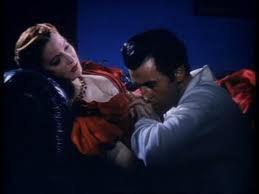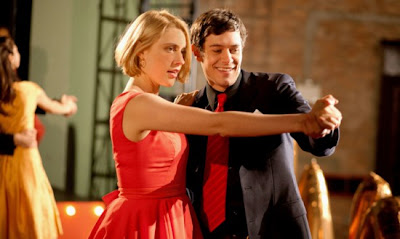The next film preservation blogathon, For the Love of Film III, is looming larger than Mount Rushmore. The Siren and her estimable blogging partners Marilyn Ferdinand of Ferdy on Films and Rod Heath of This Island Rod have already sounded the call for posts, but we are sounding it again.
Soon we'll be releasing information to the media about our drive to raise funds for the National Film Preservation Foundation and its White Shadow project. The NFPF wants to stream the movie for all to see and record the score by Michael Mortilla.
If you already signed up, there's no need to do so again; but if you haven't, and you plan to blog, step up and be counted. Leave a comment here, at Marilyn's place, or drop one of us a line at our emails, located right on the sidebars. Marilyn, Rod and the Siren welcome posts on director Graham Cutts, Alfred Hitchcock, film preservation, film scores, silent films, and if you've got something even more original, we're all ears. All are more than welcome, and by all means tell your friends.
Meanwhile, as an aperitif, the Siren is posting the complete version of a piece she did for the now-defunct Nomad Widescreen last year, on Farley Granger's two Hitchcock films. It's been revised and updated, and reflects the fact that the Siren has since read Granger's fine autobiography, Include Me Out.
Farley Granger’s own favorite among his movies was Luchino Visconti’s Senso (1954); he made several other highly regarded films, including Nicholas Ray’s They Live by Night (1949) and Anthony Mann's Side Street (1950), as well as some interesting curios like the pro-Soviet The North Star, and box-office successes that haven’t lingered in the public’s memory, like Hans Christian Anderson (which Granger synopsized as “boy meets girl; boy loses girl; boy gets boy”).
But the two most widely seen Farley Granger movies are, and will probably remain, the two he made with Alfred Hitchcock: Rope, from 1948, and Strangers on a Train, from 1951. His death last year at age 85 prompted tributes to both films, especially the magnificent Strangers.
The earlier movie, Rope, is the more problematic, but the Siren likes it, a lot. Each time she sees it, the film strikes her as more genuinely cinematic (see Glenn Kenny's discussion of this very concept with regard to the set-bound Carnage). Several moments are as chilling as anything in Hitchcock, and certain effects still knock the Siren sideways. She'll never get tired of watching the light gradually fade from the vast windows of the two murderers' apartment--New York as a brooding, implacable offstage character.
Rope is usually described as an interesting experiment that didn’t quite come off, a party line that Granger himself subscribed to. Hitchcock shot in long takes of up to ten minutes, breaking them up mostly by panning into an object that disguises the cut with a brief moment of dark screen.
There's definitely a “look ma, no hands” to the idea of Hitchcock, famous for the subtlety and rhythm of his compositions and cuts, throwing away those tools. Rather than being just stagey, however, Rope becomes a long game with the very notion of staginess, as the camera forces points of view that a theatre audience would never get. In one extraordinary instance, the lens stays trained on the maid who’s tidying up the chest that holds the dead body. The camera watches her clear the dishes from this macabre buffet table, blow out the candles, take away the tablecloth and prepare, perhaps, to open the chest; and all the while, just out of sight range, we hear the others discussing the dead man’s whereabouts.
The movie is based on the Leopold and Loeb murder case, two young men in Chicago who murdered a 14-year-old boy to demonstrate their intellectual superiority. It has often been argued that the two murderers were lovers. Montgomery Clift was offered Granger’s role in Rope but turned it down, quite possibly because he feared the light it would shine on his own proclivities; indeed, Clift turned down Sunset Boulevard for similar reasons, because of his involvement with the much-older singer Libby Holman. Granger, who at age 22 had already embarked on a lifelong pursuit of both men and women, had no such hesitation. He later said that he always considered himself a working actor, not a star, and Granger didn’t fear the homoerotic subtext of either of the films he did for Hitchcock.
Mind you, in his autobiography Granger says he spent years disappointing critics and interviewers when asked about discussions with Hitchcock about just what was going on between Rope's two main characters: "What discussions? It was 1948." That didn't mean, though, that Granger himself and co-star John Dall were clueless. For one thing, Granger was talking to screenwriter Arthur Laurents, with whom he had just embarked upon an affair:
Arthur made sure that I was aware of what he felt was going on between the characters, and, of course, John Dall and I discussed the subtext of our scenes together. We knew that Hitch knew what he was doing and had built sexual ambiguity into his presentation of the material. Jimmy Stewart must have known that the film was based on Leopold and Loeb, but I'm sure he felt that as far as his character was concerned, any implied sexual relationship between his students was strictly their business.Rope posits a classic case of criminal folie a deux, with Brandon (John Dall) as the more dominant partner, but Granger is no mere pawn, and that isn’t the way he plays it. After all, it is Philip who is strangling their friend in the opening sequence, not Brandon. Sure, Philip is weak, but that is never synonymous with powerless. Instead Philip uses his weakness to go after what he wants, which is to get caught.
That desire is there in his curt “don’t” when Dall tries to switch on the light after the murder. And it’s even more apparent when amateur psychic Constance Collier, when asked how his piano concert will go, tells him “these hands will bring you great fame”--Granger’s expression is not fear, but remorse. The steadily rising hysteria of Philip’s behavior is such that he’d have to be an idiot not to know that he’s giving the game away, and Philip is no idiot. He’s working toward his goal, using the weak person’s tools of manipulation and provocation.
So Granger’s most famous moment in the movie, when James Stewart’s ex-headmaster questions Granger and his more domineering partner in crime, isn’t simply about abject fear. He’s also playing regret and self-loathing: “Who’s the cat, and who’s the mouse?” The cat, in terms of manipulating the conversation and ensuring that Stewart becomes even more suspicious, may well be Granger himself. When Granger cracks at the end and threatens Dall with a gun, he plays the action with less agitation, not more--he’s come close to his desire at last.
Strangers on a Train, made three years later, gives Granger a similar premise and character. He plays another man, Guy Haines, trying to extricate himself from a situation he was lured into, the degree of Guy’s complicity being something even Guy can’t quite work out for himself. Certainly this handsome tennis player has violence in him, as when he grabs his scheming wife in front of a store full of customers and shakes her until a manager intervenes. Unlike Philip, Guy has enough of a self-preservation instinct to pull back at the last minute, however attractive he may find Robert Walker’s offer of murder, or indeed Walker himself.
Granger has less to say in Include Me Out about the themes of Strangers, figuring perhaps that they'd been hashed out enough elsewhere. He does tell a well-known story about seeing Hitchcock slouched and unhappy in his chair, asking what was wrong, and getting the response, "Oh, I'm just bored." The creative work was already done, and the director was transferring "from paper to film," no more excited than an author retyping a manuscript. Despite Hitchcock's ennui, Granger said Strangers was the happiest set he ever worked on.
Granger’s playing of that first scene on the train is a marvel. Walker leans in, his words pleasant and flattering, as the lines of his mouth and the glitter in his eyes imply all sorts of interest in the good-looking man across the table. Granger keeps his legs crossed and his body closed off. Guy's responses to Bruno's come-ons have the polite perfunctory quality he might use for a bore droning on about Eisenhower’s budget proposals, but the intensity of Granger's eye contact with Walker suggests a response that Guy may not even be admitting to himself. Later, confronted with incontrovertible proof that Bruno meant it all, Guy's disbelief seems ever more hollow.
Dan Callahan describes Guy as “one of Hitch’s most unappealing heroes,” and the Siren has to agree, although she's got other candidates. But what does Guy do, exactly, aside from shaking his wife? He doesn’t tell Bruno to murder anybody, and when he finds that Bruno has, he tries to bring him to justice. He plays tennis, he goes to dinner, he doesn't lie to his sweetie Ruth Roman about still being technically married. He even rescues a little boy in the carousel scene.
What’s unsympathetic in Guy comes from Granger’s performance--the shifting eyes, the impatient, petulant tone, the “everything happens to me” attitude he brings to so much of what happens; and that choice shows great nerve on Granger’s part. Given a role of ambiguous morality, he increases the questions about the character, rather than trying to emphasize the good-Guy qualities.
That service to both Hitchcock’s movies probably didn’t do Granger’s potential leading-man status any favors. A big male star may show violence, ambivalence, a lack of ethics, but those things are supposed to come roaring out from manly inner demons. Playing character flaws brought out by a stronger character’s manipulation isn’t a choice likely to vault someone to a spot above the title. In 2007 Granger told critic Stephen Whitty, “I wasn't going to listen to anyone saying you can't do this, you can't do that. I didn't care about that. I was just going to go my own way." Looking back at his two most famous movies from a distance of sixty years, there's no doubt that he meant it.





































